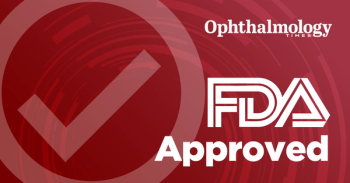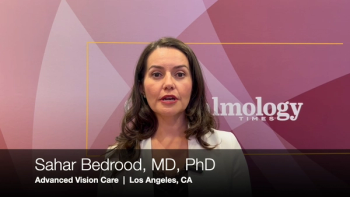
Study suggests ranibizumab superior for edema secondary to BRVO
Head-to-head randomized controlled study found ranibizumab to show more favorable results to treating macular edema secondary to BRVO than a single dose of dexamethasone.
Take-Home Message: Head-to-head randomized controlled study found ranibizumab to show more favorable results to treating macular edema secondary to BRVO than a single dose of dexamethasone.
By Michelle Dalton, ELS; Reviewed by Simon R.J. Taylor, MA, PhD
London-The first head-to-head randomized controlled clinical study comparing ranibizumab and dexamethasone for the treatment of macular edema secondary to branch retinal vein occlusion (BRVO) suggests “treating to visual stability with ranibizumab followed by a p.r.n. re-injection regime achieves better results over a 6-month period as apposed to a single injection of dexamethasone,” said Simon R.J. Taylor, MA, PhD, London.
Until the last decade, macular laser treatment was the standard of care for persistent macular edema secondary to BRVO. Now, two approved intravitreal pharmaceutical therapies are also available: the anti-VEGF agent ranibizumab and the sustained-release dexamethasone implant. However, to date, there had been no head-to-head studies comparing the two treatments.
Anti-VEGFs and steroids
VEGF is the major cytokine released by hypoxic retinal tissue in RVO and thus forms a significant therapeutic target, Dr. Taylor said.
Ranibizumab (Lucentis, Genentech) was approved in the United States in 2010 for the treatment of visual impairment due to macular edema following BRVO and central retinal vein occlusion (CRVO) based on the results of two phase III randomized, controlled studies, BRAVO and CRUISE.1-4
A second treatment approach centers on corticosteroids, based on their anti-inflammatory effects as well as their ability to reduce vascular permeability. Dexamethasone (Ozurdex, Allergan), a sustained-release biodegradable implant, was approved by the FDA in 2011, based on the results of the phase III randomized, sham-controlled, GENEVA trial.5
“Both studies showed the drugs to be effective, but there’s been debate over which one is better because the patient population studies were different,” Dr. Taylor said. “Also, the way that the GENEVA (dexamethasone) study was constructed, it’s quite difficult to tell exactly how long the [dexamethasone] implant was effective.”
It was the hope of the COMRADE-B (Efficacy and Safety of Ranibizumab Intravitreal Injections Versus Dexamethasone Intravitreal Implant in Patients With BRVO) study to address that issue, he said.
“Although the pharmacokinetic data would suggest a 6-month duration, in clinical practice, the post-marketing experience has been that (dexamethasone) had a more limited duration than that,” Dr. Taylor said. “For me, the major point of the COMRADE-B study was to show what the relative effect of each drug was in a similar patient population.”
COMRADE-B was a phase IIIb, multicenter, randomized, two-treatment arm (ranibizumab versus dexamethasone), double-masked study funded by Novartis AG. It was designed to show that ranibizumab had superior efficacy and safety compared with dexamethasone over a 6-month period.
In the treatment phase, eligible patients received consecutive monthly intravitreal injections with 0.5-mg ranibizumab until visual acuity stability was achieved (defined as a patient’s visual acuity being stable for 3 consecutive monthly assessments performed while on ranibizumab treatment), followed by a p.r.n. re-treatment if there was a decline from stable visual acuity levels, or a single intravitreal dexamethasone (700 μg) and sham injections thereafter.
Initial results
A total of 244 patients were randomly assigned and received at least 1 dose of study drug 0.5-mg ranibizumab (n = 126) or dexamethasone (n = 118) at 64 sites in Germany, the United Kingdom, Poland, Hungary, and Czechoslovakia. The mean time from diagnosis of BRVO to baseline visit was 57 days. Mean baseline best-corrected visual acuity (BCVA) ETDRS letter scores were 57 and 58, and mean baseline central retinal thickness (CRT) were 540 169 μm and 546 μm for the ranibizumab and dexamethasone groups, respectively.
Ranibizumab showed superior efficacy to dexamethasone with respect to mean average change in BCVA from baseline to month 1 and through month 6, Dr. Taylor said.
Dr. Taylor expected dexamethasone to be a 3-month drug of duration in central RVO, “for BRVO, a 4-5 month drug, and for uveitis, a 5-6 month drug. So I was a bit surprised to see that in BRVO, the effect is already declining by month 3,” he said, although he did add the improvement seemed to hold steady from month 3 through month 6.
Overall post-baseline values, patients in the ranibizumab group gained a mean BCVA of 14.2 letters (95% CI; 12.5, 15.7) compared with 9.7 (7.9, 11.4) in the dexamethasone group, which was statistically significant (p < 0.0001). A greater proportion of patients gained more than 3 lines in the ranibizumab group (61%) than in the dexamethasone group (37%).
Likewise, the percentage of patients who lost at least 1 line was higher in the dexamethasone group than in the ranibizumab group (11.9% versus 3.2%, respectively).
Along with the improvements in BCVA, there was a rapid decrease of CRT in both treatment groups. The mean CRT decreased by 245 μm in the ranibizumab group and by 269 μm in the dexamethasone group after 2 months. There was then a rebound increase, but this was more pronounced in the dexamethasone group, Dr. Taylor said.
“Some people are extremely aggressive in treating to the fullest maximum reduction in central retinal thickness,” Dr. Taylor said, “but the data from the COMRADE trial suggests that that doesn't necessarily translate into visual acuity improvement in at least the sort of trend data that we see.”
Safety data
A total of 135 patients (55%) experienced an ocular adverse event in the study eye, and 156 patients (64%) experienced a systemic adverse event, but most events were not considered to be related to the study drug, Dr. Taylor said.
Not unexpectedly, there were significantly more patients in the dexamethasone group with a minimum 10% increase in IOP from baseline compared to the ranibizumab group, but by month 4 had quieted down.
Adverse events were similar between the two groups as well (with IOP spikes the exception).
A planned extension study (to 12 months) is currently running in Germany, Dr. Taylor noted.
References
1. Campochiaro PA, Heier JS, Feiner L, et al. Ranibizumab for macular edema following branch retinal vein occlusion: six-month primary end point results of a Phase III study. Ophthalmology. 2010;117:1102-12.e1.
2. Brown DM, Campochiaro PA, Bhisitkul RB, et al. Sustained benefits from ranibizumab for macular edema following branch retinal vein occlusion: 12-month outcomes of a Phase III study. Ophthalmology. 2011;118:1594-1602.
3. Brown DM, Campochiaro PA, Singh RP, et al. Ranibizumab for macular edema following central retinal vein occlusion: six-month primary end point results of a Phase III study. Ophthalmology. 2010;117:1124-1133.e1.
4. Campochiaro PA, Brown DM, Awh CC, et al. Sustained benefits from ranibizumab for macular edema following central retinal vein occlusion: twelve-month outcomes of a Phase III study. Ophthalmology. 2011;118:2041-2049.
5. Haller JA, Bandello F, Belfort R Jr, et al. Randomized, sham-controlled trial of dexamethasone intravitreal implant in patients with macular edema due to retinal vein occlusion. Ophthalmology. 2010;117:1134-1146.e3.
6. Haller JA, Bandello F, Belfort R Jr, et al. Dexamethasone intravitreal implant in patients with macular edema related to branch or central retinal vein occlusion twelve-month study results. Ophthalmology. 2011;118:2453-2460.
Simon R.J. Taylor, MA, PhD
This article was adapted from Dr. Taylor’s presentation during Retina Subspecialty Day at the 2014 meeting of the American Academy of Ophthalmology. Dr. Taylor is on the advisory boards of Allergan, Novartis, and Santen, and receives clinical trial support from Alcon Laboratories, Allergan, Bayer, and Novartis.
Newsletter
Don’t miss out—get Ophthalmology Times updates on the latest clinical advancements and expert interviews, straight to your inbox.



















































.png)


